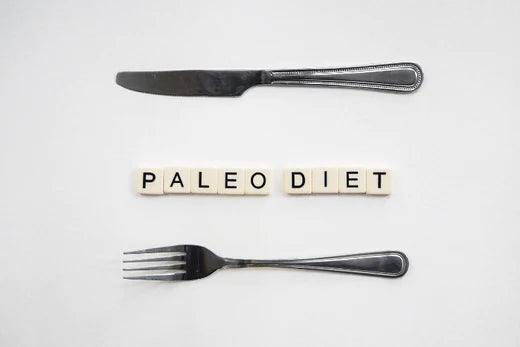Is a Paleo Diet Right for Me?: Paleo Diet for Healthy Blood Sugar Levels

Did your ancestors suffer from blood sugar issues? Probably not. Here’s why.
In the way, way back our ancestors didn’t have to deal with a lot of the stressors created by modern living.
Inflation? Nope. Road Rage? Not unless you were penned in by a herd of wooly mammoths. Even the diet they ate, some say, made life a lot easier for them – or at least for their blood sugar levels!
Enter the Paleo Diet.
The idea behind the Paleo Diet is, if we return to the diet our ancestors ate–high protein, and lots of veggies–we’ll avoid some of the health issues that currently plague us, like inflammation, wonky blood sugar levels, and food toxins.
The Paleo Diet is quite popular right now as a modern-day "cure-all." But is it? Let’s unpack the theory behind the Paleo diet, explore some of its benefits, and see if it's a good fit for you.

What is Paleo, anyway?
The Paleo (short for Paleolithic) diet was coined by health scholar Loren Cordrain. Cordrain says that humans were genetically and evolutionarily designed to eat foods available during the Paleolithic, or Stone Age, era. So, meat, fish, and vegetables.
Our agriculturally-based diet is a rather recent development when it comes to humans, really just in the last 10,000 years or so. Which may seem like a long time to us, but not-so-much when it comes to adaptation of the species–just ask Darwin! The reasoning is that our bodies haven’t exactly caught up with our culinary innovations. Not to mention all the processed and chemically-altered foods of the past hundred years or so!
Suffice it to say, our guts need a break.
It's especially true when it comes to how we, as humans, react to the foods we eat, our ability to stave off disease, and the very survival of our species.
While the food supply has changed dramatically over time—beginning with the agricultural revolution 10,000 years ago, followed by the introduction of dairy farming 5,000 years ago, and, finally, the more recent industrial revolution—our genetic makeup has not.
Humans are capable of adapting to change. In fact, from an evolutionary standpoint, we can often develop an ability to digest certain foods that our ancestors couldn’t. Take, for example, milk. Our ability to process the lactose in milk is a rather recent human adaptation. But when measured in terms of generations, we adapt pretty slowly. Slow adaptation can cause a misalignment between our physiology and our surroundings.
Over 70% of the foods we consume have been introduced since our last major evolutionary transition, and we’re struggling to catch up.

Why go Paleo?
The Paleo Diet is a low-glycemic diet that supports blood glucose tolerance and insulin resistance while also helping to prevent related conditions like obesity, hypertension, and more.
The heart of the diet (and healthy for your heart) includes unprocessed foods like:
- lean meats
- vegetables
- fruits
- and nuts
In contrast, the naughty list includes processed foods such as:
- refined sugars
- refined grains
- refined vegetable oils
- trans fatty acids
- salt
- additional chemicals
- grains
- dairy
- legumes
- simple sugars
- and artificial sweeteners
Because, well, cavemen didn't eat that kind of food, right? If you find a way to hunt aspartame, let us know.
Advantages of Paleo:
- Improved cholesterol levels
- Lower blood pressure
- Improved glycemic control
- Improved insulin sensitivity
- Better gut health
- Feeling more satisfied/full
- Weight loss and a smaller waist measurement

How to eat Paleo
Essentially, you can tailor the Paleo Diet to your specific needs and tastes–it's more of a suggested way of eating than a meal-plan. Some folks choose a low-carb, high-animal-protein approach, whereas others eat in a more high-carb, plant-based style.
This is not a one-size-fits all diet, it's a find what works for you and stick-to-it diet, provided you stick to the following guidelines:
- Remove simple sugars from your diet
Most of us are consuming far more sugar than the government recommends–thanks, soda pop! According to the National Institutes of Health (NIH), added sugars (not the ones found naturally in things like fruit and milk) account for roughly 15% of all calories consumed by individuals in the United States.
Excess sugar consumption has been linked to several health problems, including:
- Obesity
- Chronic inflammation
- Type 2 diabetes
- High blood pressure
- High cholesterol
Reducing the amount of sugar in your diet can assist in lowering your risk of developing certain diseases. And by substituting paleo foods for the high-sugar ones, you’ll not only decrease your chances of getting these diseases, but you’ll also increase your intake of dietary fiber and vital vitamins and minerals, all without adding calories.
- Consume high-quality protein
Protein is necessary for good health, but most Americans are eating low-quality protein. Factory-farmed meat contains fewer antioxidants than grass-fed meat. Antibiotics and poor-quality feed given to the animals has an enormous impact on meat quality. Choose grass-fed meat and wild-caught seafood whenever available to get the most out of your protein.
- Avoid foods that cause inflammation
You’ve probably heard about the gluten-free vegan craze that every celebrity seems to be adopting these days. But do you know why?
It's because grains and dairy products are among the foods that cause the most inflammation in your body.
In fact, modern, gluten-filled grains don’t even resemble the ancient grains from which they evolved. Wheat has been engineered to be more pest-resistant and provide larger yields in modern times.
Good for the farmers, but not so much for the folks eating it. Modern wheat contains more anti-nutrients, such as gluten and -Amylase/Trypsin Inhibitors, than traditional wheat.
Basically, gluten = inflammation.
That’s why grains and dairy are not allowed in the Paleo Diet. By eliminating them you can reduce inflammation and improve your gut health, immunity, and digestion.

Can the Paleo Diet help me stabilize my blood sugar?
You're not the only one who wonders this. Many people with blood glucose issues follow the Paleo Diet to improve insulin sensitivity, control blood sugar, and improve overall blood glucose management. Paleo diets are particularly beneficial in helping with weight loss, enhanced insulin sensitivity, and improved systolic blood pressure.
In fact, a 2015 study published in the European Journal of Clinical Nutrition followed 14 individuals with type 2 diabetes who followed the Paleo diet and compared them to 10 people with type 2 diabetes who only followed the American Diabetes Association's (ADA) typical diet.
The results were pretty impressive. The folks who followed the Paleo diet discovered that it drastically reduced their blood pressure, stabilized their blood sugar levels, and lowered their cholesterol in just two weeks. Whereas, the ADA diet folks reported little to no improvement.
Just remember, if you're thinking about following the Paleo Diet, talk to your doctor or a dietician first to see if the diet is proper for you.

Paleo Diet vs. Western Diet
You might be wondering why the Paleo Diet eliminates entire grains, dairy, and legumes when these foods have been a staple of the Western diet for decades.
The truth is that most Americans consume considerably more carbohydrates than they need daily, as seen by our expanding waistlines. Low-grade inflammation, which is at the root of most chronic illnesses, has been linked to this highly processed diet.
Many specialists now believe that carbs (particularly processed foods like bread and pasta) and grains stimulate the appetite.
In effect, our brain reacts to carbs differently than it does to more nutrient-rich foods like meats and vegetables.
Think about it, how many potato chips can you eat before you feel full? Whereas, how much chicken breast can you eat to get the same full feeling? Carbs tend to make the body hungrier, because you’re not getting much nutrition! You’re essentially just pumping your body with foods that rapidly transform into sugar.
Some of the Paleo Diet's most advantageous components are the sodium-to-potassium ratio and omega-3-to-omega-6 ratio. In the Western diet, high salt levels combined with low potassium levels cause inflammatory issues which can lead to cardiovascular risk factors, autoimmune disorders, and even osteoporosis.
Whereas, a Paleo Diet rich in omega-3 fatty acids (as opposed to omega-6 fatty acids) is anti-inflammatory. Unlike the Western diet, the Paleo Diet is a naturally anti-inflammatory diet that helps prevent rather than increase chronic disease.
Paleo Diet devotees also say that they experience the following health benefits:
- Reduced inflammation in the body
- Decreased cardiovascular risk factors
- Weight loss
- Reduce bloating
- Better skin
- Better glycemic control
- Increased energy
What about other diets?
When compared to the more traditional Diabetes diet, the Paleo Diet results in lower triglycerides, lower blood pressure, weight loss, and decreased BMI and waist size. However, while the health benefits of Paleo eating have been widely publicized, many experts question if it is superior to a Mediterranean, Ketogenic, or Vegan diet, which all emphasize complete foods but are less restricted.

So you think you wanna go Paleo?
If all of this sounds great, and you think you want to attempt a Paleo Diet, here's a few precautions and considerations for folks with certain health conditions.
First and foremost, we recommend you talk to your doctor or a qualified dietician to get started–especially if you have special concerns like kidney function or are using certain medications. So chat with your doctor first.
Likewise, folks with digestive problems may not be able to tolerate the Paleo Diet because it includes a lot of foods naturally rich in protein and not a lot of fiber. Paleo can cause a little backup in the plumbing, so to speak. So make sure you get your ruffage.
Because the Paleolithic diet requires you to avoid certain food groups, your body may take some time to adjust. As a result, some side effects may occur. These are not the same for everyone and many people seem to have no adverse effects at all, but best to let your doctor know if you’re planning on making the switch to Paleo.
Takeaway on the Paleo Diet
The bottom line: if you eat like your ancestors you may not have to deal with some of the modern diseases that are a byproduct of the modern diet.
This, combined with the fact that no one's going to get trampled by a herd of wooly mammoths these days, should put you well ahead of the life-expectancy curve in the Stone Age and perhaps even today.




